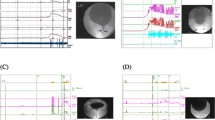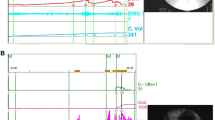Abstract
Introduction and hypothesis
Patient history is often insufficient to identify type of urinary incontinence (UI). Multichannel urodynamic testing (UDS) is often used to clarify the diagnosis. Dynamic cystoscopy (DC) is a novel approach for testing bladder function. The primary objective of this study was to investigate the diagnostic agreement of UDS and DC in evaluating women with mixed urinary incontinence (MUI).
Methods
Women presenting with MUI were approached for enrollment if UDS and DC were planned for further investigation. Investigators were blinded to history and comparative test results. McNemar’s test and kappa coefficient were calculated to assess agreement between UDS and DC. Receiver operating characteristic (ROC) analysis was used to explore the best possible filling sensation cutoffs for DC that would best predict the filling sensation cutoffs from UDS.
Results
Sixty participants were included, of whom, four were excluded for protocol violation. For the primary outcome measure of agreement, UDS and DC were concordant in 44/56 of stress urinary incontinence (SUI) cases (79%) with a κ= 0.54 and in 43/56 of urinary urge incontinence (UUI) cases (77%) with a κ= 0.54, indicating moderate, nearly substantial agreement. ROC analysis identified the best prediction of DC first urge to void as 148 cm3, strong urge 215 cm3, and maximum capacity at 246 cm3. These parameters were used to compare UDS UUI to DC UUI and resulted in a κ = 0.61 (p = 0.37), indicating substantial agreement.
Conclusions
When compared with UDS, DC shows moderate agreement for detection of SUI and substantial agreement for detection of UUI.
Similar content being viewed by others
Abbreviations
- UDS:
-
Urodynamic testing
- DC:
-
Dynamic cystoscopy
- MUI:
-
Mixed urinary incontinence
- ROC:
-
Receiver operating characteristic
- SUI:
-
Stress urinary incontinence
- UUI:
-
Urge urinary incontinence
- ICS:
-
International Continence Society
- DO:
-
Detrusor overactivity
- UU:
-
Urinary urgency
- OAB:
-
Overactive bladder
- UTI:
-
Urinary tract infection
- POP-Q:
-
Pelvic Organ Prolapse Quantification
- PVR:
-
Postvoid residual
- MCC:
-
Maximum cystometric capacity
- IUGA:
-
International urogynecological association
- ISD:
-
Intrinsic sphincter deficiency
- MUCP:
-
Maximum urethral closure pressure
- QUID:
-
Questionnaire for urinary incontinence diagnosis
- SUDS:
-
Subjective Units of Distress Scale
References
Abrams P, Cardozo L, Fall M, Griffiths D, Rosier P, et al. The standardisation of terminology in lower urinary tract function: report from the standardisation sub-committee of the international continence society. Urology. 2003;61(1):37–49.
Haylen BT, de Ridder D, Freeman RM, Swift SE, Berghmans B, et al. An international Urogynecological association (IUGA)/international continence society (ICS) joint report on the terminology for female pelvic floor dysfunction. Int Urogynecol J. 2010;21:5–26. https://doi.org/10.1007/s00192-009-0976-9.
van Leijsen SA, Hoogstad-van Evert JS, Mol BW, Vierhou ME, Milani AL, Heesakkers JP, et al. The correlation between clinical and urodynamic diagnosis in classifying the type of urinary incontinence in women. A systematic review of the literature. Neurourol Urodyn. 2011;30(4):495–502. https://doi.org/10.1002/nau.21047.
Scarpero H. Urodynamics in the evaluation of female LUTS: when are they helpful and how do we use them? Urol Clin N Am. 2014;41(3):429–38, viii-ix. https://doi.org/10.1016/j.ucl.2014.04.010.
Digesu GA, Salvatore S, Fernando R, Khullar V. Mixed urinary symptoms: what are the urodynamic findings? Neurourol Urodyn. 2008;27(5):372–5. https://doi.org/10.1002/nau.20530.
Verghese TS, Middleton LJ, Daniels JP, Deeks JJ, Latthe PM. The impact of urodynamics on treatment and outcomes in women with an overactive bladder: a longitudinal prospective follow-up study. Int Urogynecol J. 2017;1–7. https://doi.org/10.1007/s00192-017-3414-4.
Richter HE, Albo ME, Zyczynski HM, Kenton K, Norton PA, et al. Retropubic versus transobturator midurethral sling for stress incontinence. N Engl J Med. 2010;362:2066–76. https://doi.org/10.1056/NEJMoa0912658.
Tanner BA. Validity of global physical and emotional SUDS. Appl Psychophysiol Biofeedback. 2012;37(1):31–4. https://doi.org/10.1007/s10484-011-9174-x.
Bump RC, Mattiasson A, Bo K, Brubaker LP, DeLancey JO, Klarskov P, et al. The standardization of terminology of female pelvic organ prolapse and pelvic floor dysfunction. Am J Obstet Gynecol. 1996;175(1):10–7.
Gammie A, Clarkson B, Constantinou C, Damaser M, Drinnan M, Geleijnse G, et al. International continence society guidelines on urodynamic equipment performance. Neurourol Urodyn. 2014;33(4):370–9. https://doi.org/10.1002/nau.22546.
Amir B, Farrell SA. SOGC committee opinion on urodynamics testing. J Obstet Gynaecol Can. 2008;30(8):717–27.
Mahfouz W, Al Afraa T, Campeau L, Corcos J. Normal urodynamic parameters in women: part II--invasive urodynamics. Int Urogynecol J. 2012;23(3):269–77. https://doi.org/10.1007/s00192-011-1585-y.
Osman NI, Chapple CR, Abrams P, Dmochowski R, Haab F, Nitti V, et al. Detrusor underactivity and the underactive bladder: a new clinical entity? A review of current terminology, definitions, epidemiology, aetiology, and diagnosis. Eur Urol. 2014;65(2):389–98. https://doi.org/10.1016/j.eururo.2013.10.015.
Parrillo LM, Ramchandani P, Smith AL. Can intrinsic sphincter deficiency be diagnosed by urodynamics? Urol Clin N Am. 2014;41(3):375–81, vii. https://doi.org/10.1016/j.ucl.2014.04.006.
Shah SM, Gaunay GS. Treatment options for intrinsic sphincter deficiency. Nat Rev Urol. 2012;9(11):638–51. https://doi.org/10.1038/nrurol.2012.177.
Epp A, Larochelle A, Lovatsis D, Walter JE, Easton W, Farrell SA, et al. Recurrent urinary tract infection. J Obstet Gynaecol Can. 2010;32(11):1082–101.
Bradley CS, Rahn DD, Nygaard IE, Barber MD, Nager CW, Kenton KS, et al. The questionnaire for urinary incontinence diagnosis (QUID): validity and responsiveness to change in women undergoing nonsurgical therapies for treatment of stress predominant urinary incontinence. Neurourol Urodyn. 2010;29(5):727–34. https://doi.org/10.1002/nau.20818.
Watson PF, Petrie A. Method agreement analysis: a review of correct methodology. Theriogenology. 2010;73(9):1167–9.
Landis JR, Koch GG. The measurement of observer agreement for categorical data. Biometrics. 1977;33(1):159–74.
Machin D, Campbell MJ, Tan SB, Tan SH. Sample size tables for clinical studies. Hoboken: John Wiley & Sons; 2011.
Scotti RJ, Ostergard DR, Guillaume AA, Kohatsu KE. Predictive value of urethroscopy as compared to urodynamics in the diagnosis of genuine stress incontinence. J Reprod Med. 1990;35(8):772–6.
Sand PK, Hill RC, Ostergard DR. Supine urethroscopic and standing cystometry as screening methods for the detection of detrusor instability. Obstet Gynecol. 1987;70(1):57–60.
Hanna-Mitchell AT, Kashyap M, Chan WV, Andersson KE, Tannenbaum C. Pathophysiology of idiopathic overactive bladder and the success of treatment: a systematic review from ICI-RS 2013. Neurourol Urodyn. 2014;33(5):611–7. https://doi.org/10.1002/nau.22582.
Lee SR, Kim HJ, Kim A, Kim JH. Overactive bladder is not only overactive but also hypersensitive. Urology. 2010;75(5):1053–9. https://doi.org/10.1016/j.urology.2009.10.045.
Almallah Y, Rennie C, Stone J, Lancashire M. Urinary tract infection and patient satisfaction after flexible cystoscopy and urodynamic evaluation. Urology. 2000;56(1):37–9.
Author information
Authors and Affiliations
Corresponding author
Ethics declarations
Conflicts of interest
None.
Rights and permissions
About this article
Cite this article
Globerman, D., Gagnon, LH., Tang, S. et al. A prospective study investigating the diagnostic agreement between urodynamics and dynamic cystoscopy in women presenting with mixed urinary incontinence. Int Urogynecol J 30, 823–829 (2019). https://doi.org/10.1007/s00192-018-3671-x
Received:
Accepted:
Published:
Issue Date:
DOI: https://doi.org/10.1007/s00192-018-3671-x




